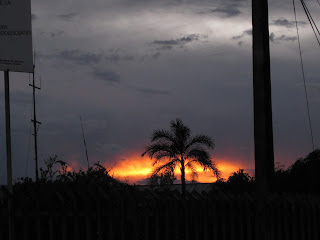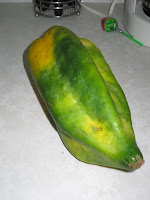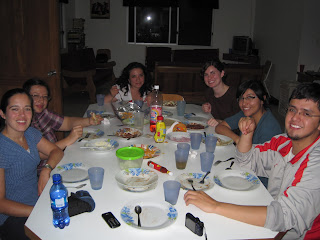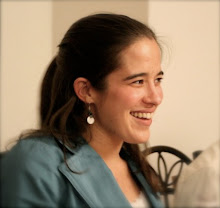The past two weekends I have gone to nearby Baños on my free weekends. It is an hour plus trip on windy mountain roads, happily reinforced by guardrails and two-lane the whole way, although drivers do still pass on the road (but not on corners nearly as much as I expected). It is a lovely trip through the unending green of the mountains with clouds visible hanging at an almost-touchable distance just above one's head. Here are some of my pictures with narrative.
This is from the first weekend trip with some residents with me trying to capture the way the wispy clouds hang on the mountainsides.

We caught the bus after a literally one-minute wait along the highway from the halfway point between Shell and Baños where the tour dropped us off and arrived back in Shell to a lovely sunset. I just don't tire of the mountains here, so different from at home. I do wish the clouds cleared up a bit more and I could see the stars (I think I could see both the Southern Cross and the Big Dipper the one night it was clear), but it makes for some lovely views.

Landslides, or derrumbes, are always an issue in the mountains, although much less so with this road than the old one. I think this was actually blasted away for the road, based on the marks in the dirt, but it reminded me of the possibility, especially with as much rain as they get here.
Baños is known for its Virgen de Agua Santa, and there is a large and beautiful church whose walls are covered with paintings of stories where the Virgen saved people falling from bridges or whose house should have burned or during one of the volcanic eruptions. This is the waterfall that overlooks the town.
Marking its location as a tourist hot spot, the busy bus depot is surrounded by many stalls of fruit and caña (sugar cane).
The lovely green mountains sweep into deep valleys invariably with a river at the bottom.
This is the plateau on which Baños is situated, overlooked by the Volcano Tunguraha, whose activity causes the hot springs and baths that give the city its name and parts of its attraction. If you look closely, there are two small waterfalls on the right falling off the plateau.
It's just beautiful.
One of the many fruit and candy (taffy) stalls, complete with stacks of caña. I managed also accidentally to get the typically dressed indigenous older man in the picture, which made me very happy.
Ha. Pork, anyone?
A typical view of the mountains surrounding Baños' plateau.
The mountains in the background, the large church to the Virgen in the mid ground, and gorgeous bougainvillea in the foreground.
A map of Baños' plateau and the roads in and out and the volcano that overlooks it. The windy road to the top left of the map goes up to Shell, second-to-last destination on the map.
The volcano itself.
One of the cascadas (waterfalls) on the Ruta de las Cascadas. This one is called the Novios (boyfriend/girlfriend). It used to be one falls alone, the one on the right and was called Manto de la Novia (the bride's veil), but after a volcanic eruption, the river divided higher up, and now the left one has been added to make the pair.
I think this one shares a name with the large dam and hydroelectric power plant, Agoyán. I'm not sure which got named first...
We took a little cable car over to close to the falls. I was glad I'm not acrophobic!
This little guy is called something related to snakes, I think Cascada de Culebra.
A view of the old road, which the older missionary doctor I was traveling with told me used to be open once a week due to landslides and muddy conditions. It wasn't paved when he started here, and it drops off steeply to the right. It didn't use to have that guard thing, either, and it was two-way, one-and-a-half lanes. The road passes under a little waterfall off the rocks, which the doctor told me they used to call the carwash. :)
This is one of later falls on the Ruta called Pailón del Diablo, or the Devil's Bowl-whirlpool, for the way the water crashes into that rock formation before flowing out at the bottom.
We caught the bus after a literally one-minute wait along the highway from the halfway point between Shell and Baños where the tour dropped us off and arrived back in Shell to a lovely sunset. I just don't tire of the mountains here, so different from at home. I do wish the clouds cleared up a bit more and I could see the stars (I think I could see both the Southern Cross and the Big Dipper the one night it was clear), but it makes for some lovely views.




















































